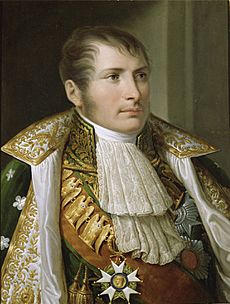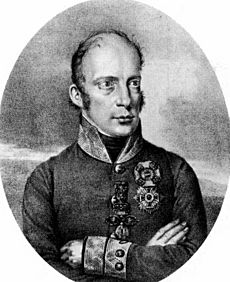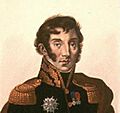Sacile 1809 order of battle facts for kids
The Battle of Sacile happened on April 16, 1809. It was a big fight between the French and Italian army, led by Eugène de Beauharnais, and the Austrian army, led by Archduke John of Austria. This battle was part of a larger conflict called the War of the Fifth Coalition.
Eugène thought he was only fighting a smaller part of the Austrian army. So, he sent a strong attack with his right side. In the morning, the Austrians successfully defended their left side against these attacks. Eugène kept sending more troops to help his attack.
Later that day, Archduke John launched a surprise attack on Eugène's left side, which had become weaker. This forced the French and Italian army to leave the battlefield. Before the main battle, there was a smaller fight in Pordenone on April 15. In that fight, the Austrian advance guard heavily damaged the French rear guard. Because of their victory at Sacile, the Austrians made Eugène retreat to the Adige River near Verona. There, he gathered more soldiers and planned his next move.
Who Fought at Sacile?
The battle involved two main armies: the Franco-Italian Army of Italy and the Austrian Army of Inner Austria. Both sides had many soldiers, cannons, and cavalry (soldiers on horseback).
The Franco-Italian Army
The Franco-Italian Army was commanded by Eugène de Beauharnais. He was the stepson of Napoleon Bonaparte. His army was made up of several divisions, each with different types of soldiers.
- Main Commander: Eugène de Beauharnais
- Chief of Staff: General of Division Henri François Marie Charpentier
- Artillery: General of Division Jean-Barthélemot Sorbier (They had 8 cannons.)
The army was organized into several large groups called divisions. Each division had thousands of infantry (foot soldiers) and some cavalry (soldiers on horseback). They also had their own cannons.
- 1st Division: Led by General of Division Jean Mathieu Seras. This division had two brigades of infantry.
- 2nd Division: Led by General of Division Jean-Baptiste Broussier. This division also had two brigades of infantry and some dragoons (soldiers who could fight on horseback or on foot).
- 3rd Division: Led by General of Division Paul Grenier. This division included light infantry, line infantry, and Italian dragoons.
- 4th Division: Led by General of Division Gabriel Barbou des Courières. This was a large division with many battalions of light and line infantry.
- Light Cavalry Division: Led by General of Division Louis Michel Antoine Sahuc. This division had several regiments of chasseurs à cheval (light cavalry) and hussars (another type of light cavalry). They also had horse artillery, which could move quickly.
- 1st Italian Division: Led by General of Division Filippo Severoli. This division included Italian line infantry, Dalmatian infantry, and Italian chasseurs à cheval. They also had their own Italian artillery.
The Austrian Army
The Austrian Army of Inner Austria was commanded by General der Kavallerie Archduke John of Austria. His army was also well-organized, with an advance guard, two main army corps, and a cavalry division.
- Main Commander: Archduke John of Austria
- Chief of Staff: Oberst (Colonel) Laval Nugent von Westmeath
- Artillery Director: General-Major Anton Reisner
The Austrian army also used divisions and brigades, which are smaller groups of soldiers.
- Advance Guard: Led by Feldmarschall-Leutnant Johann Maria Philipp Frimont. This was the first group of soldiers to move forward. It included infantry and hussars.
- VIII Armeekorps: Led by Feldmarschall-Leutnant Albert Gyulai. This corps had its own artillery and several brigades of infantry and cavalry, including hussars and chevau-légers (light cavalry).
- IX Armeekorps: Led by Feldmarschall-Leutnant Ignaz Gyulai. This was another large corps with its own artillery. It had many brigades of infantry, including grenadiers (elite infantry) and Landwehr (militia).
- Cavalry Division: Led by Feldmarschall-Leutnant Christian Wolfskeel von Reichenberg. This division had many squadrons of hussars and dragoons, which were important for fast attacks and chasing enemies.
Images for kids







